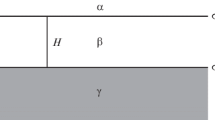Abstract
This investigation considers the suitability of the moiré method as a technique for determining the dynamic response of thin membranes. Specimen preparation, test apparatus and test results are reported for a circular and a rectangular membrane. The applicability of the method for measuring transient as well as periodic behavior is discussed. Theoretical and experimental values are compared for the case of periodic response.
Similar content being viewed by others
Abbreviations
- N :
-
tensile force in membrane (lb/in.)
- η:
-
deflection
- ρ:
-
mass density per unit area of membrane (lb sec2/in.2)
- t :
-
time (sec)
- Z :
-
total impedance of membrane and surrounding air
- Z m :
-
mechanical impedance of membrane
- Z a :
-
mechanical impedance of surrounding air
- A :
-
viscous or damping portion of air impedance
- B :
-
stiffness and mass portion of air impedance
- i :
-
square root of −1
- ω:
-
circular frequency (rad/sec)
- a :
-
length of rectangular specimen (alongx)
- b :
-
width of rectangular specimen (alongy)
- c :
-
outer radius of circular specimen
- x andy :
-
coordinates associated with rectangular specimen
- r and θ:
-
coordinates associated with circular specimen
- m :
-
number of nodal diameters in circular
- n :
-
number of nodal circles in circular specimen
- J n :
-
denotes Bessel function of first kind and orderm
- μ:
-
number of half wavelengths inx direction on rectangular membrane
- v :
-
number of half wavelengths iny direction on rectangular membrane
- α:
-
\(\sqrt {N/\rho } \)
References
Miles, D. O., “Direct Mechanical Determination of the Dynamic Response of Diaphragms,” Jnl. ASA,36 (8), (1964).
Chobotov, V. A., and Binder, R. C., “Nonlinear Response of a Circular Membrane to Sinusoidal Excitation,” Ibid. Jnl. ASA, (1), (1964).
Rule, E., Suellentrop, F.J., and Perls, T. A., “Second-Order Instrumentation Systems With Frequency-Dependent Stiffness and Damping,” Ibid. Jnl. ASA,31 (11), (1959).
Brüel and Kjaer Technical Review, “Pressure Equalization of Condenser Microphones,” No. 1 (1960).
Ligtenberg, F. K., “The Moiré Method,”Proc. SESA, XII (2),83–98 (1955).
Morse, P. M., “Vibration and Sound,” McGraw-Hill Book Co. 1948.
Handbook of Experimental Stress Analysis, Ed. M. Hetényi, John Wiley & Sons, 1950.
Author information
Authors and Affiliations
Rights and permissions
About this article
Cite this article
Nickola, W.E. The dynamic response of thin membranes by the moiré method. Experimental Mechanics 6, 593–601 (1966). https://doi.org/10.1007/BF02326827
Issue Date:
DOI: https://doi.org/10.1007/BF02326827




